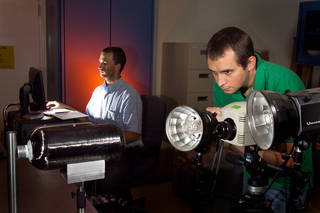
Through collaboration with other government agencies, U.S. national consensus organizations, and international governments, our engineers have developed nondestructive evaluation (NDE) standards for composites through ASTM International.
Along with being lead supporters of NDE standards development through the NASA NDE Development Program, our team has pioneered many pressure vessel testing methods accepted by the American Institute of Aeronautics and Astronautics (AIAA) as standard practice and we continue to work closely with AIAA to maintain several standards of COPV design, testing, and certification.
In addition to our facilities’ contribution to standards development, our engineers have extensive experience with applicable NASA and ISO standards that apply to COPVs.
American Institute of Aeronautics and Astronautics (AIAA)
- Space Systems—Metallic Pressure Vessels, Pressurized Structures, and Pressure Components (ANSI/AIAA S-080A-2018)
- This standard lays the foundational requirements for design, analysis, fabrication, and operation of various pressurized components. Additionally, the standard outlines requirements for maintaining several types of pressure vessels and pressurized structures and components (AIAA 2018)…Learn more
- Space Systems—Composite Overwrapped Pressure Vessels (ANSI/AIAA S-081B-2018)
- This standard covers foundational requirements for composite overwrapped pressure vessels (COPVs) fabricated with metal liners and carbon fiber/polymer overwrap. The standard includes requirements for COPV design, analysis, fabrication, test, inspection, operation, and maintenance (AIAA 2018)…Learn more
- Space Systems—Non-Metallic Composite Overwrapped Pressure Vessels (In-Development)
ASTM International
- Standard Practice for Shearography of Polymer Matrix Composites, Sandwich Core Materials and Filament-Wound Pressure Vessels in Aerospace Applications (ASTM E2581)
- This ASTM standard (E2581) provides practices for shearography, which is used to measure strain, shearing, Poisson, bending, and torsional strains. Shearography proves useful during process design and optimization, and process control. Additionally, it can be used after manufacture and in-service inspections (ASTM 2019)…Learn more.
- Acoustic Emissions Standard
- Standard Practice for Examination of Gas-Filled Filament-Wound Composite Pressure Vessels Using Acoustic Emission (ASTM E2191)
- With safety in mind, guidelines have been composed by Compressed Gas Association (CGA) and others to focus on inspections for natural gas vehicle (NGV) fuel containers. Acoustic Emission (AE) testing of Gas-Filled Filament-Wound Composite Pressure Vessels is an alternative method to the three-year visual examination which requires removal of the container from the vehicle (ASTM 2016)… Learn more.
- Standard Practice for Acoustic Emission Examination of Plate-like and Flat Panel Composite Structures Used in Aerospace Applications (ASTM E2661)
- Acoustic Emission (AE) examination of plate-like and flat panel composite structures proves useful in detecting micro-damage generation, new or existing flaws, and accumulation. Furthermore, AE examination assists in locating damage such as matrix cracking, fiber splitting, fiber breakage, fiber pull-out, debonding, and delamination (ASTM 2020)… Learn more.
- Standard Practice for Acousto-Ultrasonic Assessment of Filament-Wound Pressure Vessels (ASTM E1736)
- The Acousto-Ultrasonic (AU) method should be carefully considered for vessels that show no major defects and weaknesses. It is key to use other methods like immersion pulse-echo ultrasonics (Practice E1001) and AE (Practice E1067) to determine the existence of major flaws before starting with AU (ASTM 2015)… Learn more.
- Standard Practice for Examination of Gas-Filled Filament-Wound Composite Pressure Vessels Using Acoustic Emission (ASTM E2191)
- Eddy Current Standard
- Standard Guide for Eddy Current Testing of Electrically Conducting Materials Using Conformable Sensor Arrays (ASTM E2884)
- Using eddy current techniques are a nondestructive way to find and identify discontinuities in magnetic or nonmagnetic electrically conducting materials. Planar and non-planar material examination is possible with conformable eddy current sensor arrays, but requires appropriate fixtures like a sturdy support frame and foam to hold the sensor array close to the surface of the material being examined (ASTM 2017)… Learn more.
- Standard Guide for Eddy Current Testing of Electrically Conducting Materials Using Conformable Sensor Arrays (ASTM E2884)
- Strand Testing Standard
- Standard Terminology for Composite Materials (ASTM D3878)
- The standard defines general composite terminology appearing in other standards about composites, containing high‑modulus fibers (greater than 20 GPa (3 × 10 6 psi)) (ASTM 2020a)… Learn more.
- Standard Test Method for Tensile Properties of Glass Fiber Strands, Yarns, and Rovings Used in Reinforced Plastics (ASTM D2343)
- Standard Terminology for Composite Materials (ASTM D3878)
NASA Standards
ISO Standards
Last Updated: Jan 13, 2021
Editor: Judy Corbett
National Aeronautics and Space Administration
Click here for original story, COPV Standards
Source: NASA Breaking News